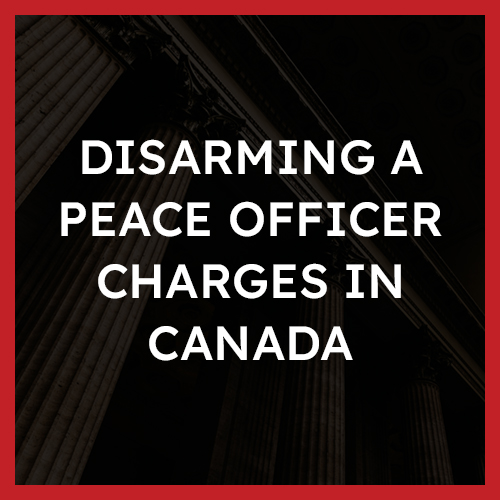Disarming a Peace Officer (s. 270.1) Laws in Canada
What is Disarming a Peace Officer?

Section 270.1 of the Criminal Code states that everyone who:
Disarms a Peace Officer:
“Every one commits an offense who, without the consent of a peace officer, takes or attempts to take a weapon that is in the possession of the peace officer when the peace officer is engaged in the execution of his or her duty.”
Examples of Disarming a Peace Officer
Some examples of the offence of Disarming a peace officer may include:
- A person tries to take the gun out of the holster on a uniformed police officer’s hip, while the police officer is in the community.
- An inmate tries to remove a less-lethal (taser, conducted energy weapon, etc.) weapon from a correctional officer while inside of a correctional facility.
Defences
A strong defence to a charge of disarming a peace officer will vary depending on the circumstances of what occurred.
However, some defences may be:
- Lack of Knowledge/ Mens Rea: A key element of the offence under Section 270.1 is the intention to disarm a peace officer. If the accused can demonstrate that they did not have the intention to disarm the officer, they may be able to successfully argue that they are not guilty of the offence, since the element of mens rea has not been met. This defence may require providing evidence or testimony that the accused accidentally or unintentionally made contact with the officer’s weapon, or perhaps that the accused was not aware that the peace officer was, in fact, a peace officer. If the peace officer was not in full uniform or was not identifiable as a peace officer, this would be information to discuss with a lawyer during a consultation.
- Lawful Excuse: Section 270.1 specifically prohibits disarming a peace officer without a lawful excuse. If the accused can establish that they had a legal reason for attempting to disarm the officer, such as self-defence or defence of another, they may be able to successfully raise this defence. However, the accused must demonstrate that their actions were reasonable and proportionate under the circumstances.
- Mistake of Fact: Another potential defence is a mistake of fact, in which the accused mistakenly believed that the individual they were attempting to disarm was not a peace officer. To successfully raise this defence, the accused must establish that their mistaken belief was both honest and reasonable under the circumstances. This may be closely tied to the above-described “lack of knowledge/ mens rea”
- Duress or Necessity: In rare cases, an accused might argue that they attempted to disarm a peace officer under duress or out of necessity, such as to protect themselves or others from imminent harm. This defence is typically difficult to establish and requires proof that the accused had no other reasonable alternatives available to them at the time. As described above under “lawful excuse”, circumstances which the accused perceived as potentially “life and death”, or perhaps to assist a peace officer who is injured or unable to draw their firearm may fall into this category. Again, however, this should be discussed during consultation with a lawyer.
Punishment
The maximum penalty for a conviction under Section 270.1 is five (5) years imprisonment. Disarming a peace officer is a hybrid offence, meaning the crown can elect to proceed either by indictment or summarily.
If the crown chooses to please summarily, the maximum penalty is 18 months imprisonment.
Whether you intend to plead guilty to a charge under section 270.1, it is important to consult a lawyer prior. There may be factors which apply to your punishment/sentencing which are relevant and important for consideration, which may result in a lesser punishment.
Overview of the Offence
Disarming a peace officer is an offence under section 270.1 of the Criminal Code of Canada. This section is designed to safeguard law enforcement from unlawful attack, as it is further to the offence of assaulting a peace officer.
Disarming a peace officer is viewed as a serious offence by the courts, as it compromises the safety of law enforcement functioning in the lawful execution of their duties, seeking the proper administration of justice.
In order for a person to be convicted of disarming a peace officer in criminal court, the crown is required to prove their case beyond a reasonable doubt. The crown must also prove several elements of the offence, such as that a person or. Proving the offence should include: confirming the accused’s identity, the date(s) and time(s) which the incident(s) occurred, the jurisdiction, that the accused intended concealing or withholding information in order to defraud the victim by causing loss. The presumption of innocence applies in that the accused is presumed innocent until convicted of the offence.
The Guilty Act (Actus Reus)
The actus reus for the offence of disarming a peace officer is established by proof, beyond a reasonable doubt, of the following:
- the accused physically disarmed a peace officer by removing them of their service-issued firearm, or conducted energy weapon by their own volition
The Guilty Mind (Mens Rea)
The mens rea for disarming a peace officer is established by proof, beyond a reasonable doubt, of the following:
- the accused, knowing the peace officer was in the execution of their duties, intended to disarm them of the above-described weapon
and
- the accused did so for an unlawful purpose
Defences
How to beat a charge of Disarming a Peace Officer
Each circumstance is different, and the best defence available is contextual based on the details. Fabricating evidence is a serious offence. However, the following are some common defences that may be used against a charge of fabricating evidence:
Proving the identity of the accused
There are several aspects to this defence, however, one may rely on whether there was evidence seized by the police, which directly implicates the accused. The accused’s identity, as well as the date, time, and location of the offence, are necessary for the crown to prove beyond a reasonable doubt.
Lack of Knowledge/Honest Mistake/No Mens Rea or Mental Intent
Lack of knowledge may also be raised as a defence in some circumstances if the accused can prove that they did not know that the Peace Officer was in fact, a Peace Officer, or in the lawful execution of their duties. The crown is required to prove beyond a reasonable doubt that this has been established.
This could also apply to circumstances where a person may inadvertently or accidentally make contact with the holster with a peace officer has their firearm secured.
Ensuring the evidence was obtained lawfully
It is advisable to consult a lawyer in such circumstances, however, there may be circumstances where evidence was obtained from the accused person without their consent, and where they held a reasonable expectation of privacy. If this is the case, it is important to seek consultation from a lawyer to ensure that the accused’s rights under section 8 of the Canadian Charter of Rights and Freedoms were not violated. If they were, there have been circumstances where the courts have deemed the evidence seized in this manner inadmissible.
For example, if following an incident, an accused person sent private text messages to a close friend discussing the incident involving a peace officer being disarmed, and the police seize and search the accused’s cellular phone without a warrant, this evidence may not be admissible. Evidence, and how it was seized, although always important to examine diligently, is especially so in circumstances which lead to a charge of disarming a peace officer. It is important to determine the accused’s expectation of privacy in this context, and whether the police obtained warrants to search the devices, or were required to.
Obtaining Property by False Pretences Defences
Colour of Right
Colour of right refers to a situation where if the facts that you believed to be true were true, you would not be guilty of the offence. An example of colour of right in the context of a section 362 offence might be that you write out a cheque for a certain amount to give in exchange for the obtainment of some property and the cheque bounces due to insufficient funds, however, you genuinely believed, that when you wrote out or cashed the cheque, that the attributable funds were available. In this scenario, you would likely not be found guilty if there was good reason for you to believe those funds would be available.
No Risk of Loss
For the actus reus element of this offence to be met, there needs to be some sort of deprivation, either actual loss or the risk of loss. As such, a possible defence to a s. 362 charge is to argue that the act in question did not result in actual deprivation or risk of deprivation.
Applicable Charter defences
The Canadian Charter sets out your rights and freedoms before and after your arrest. If the police fail to abide by these rights, either deliberately or inadvertently, it could aid in your defence. If any of your Charter rights have been violated before or after your arrest, you may be able to have some or all of the evidence that the Crown is relying on to secure a conviction excluded under s.24(2) of the Charter.
Punishments
The maximum penalty for a conviction under Section 270.1 of the Criminal Code is a term of imprisonment of up to five (5) years. It is a hybrid offence, therefore the crown may elect to proceed either by way of indictment or summarily/by summary conviction. If the crown chooses to proceed summarily, the maximum sentence is a punishment not exceeding 18 months of incarceration.
Whether you intend to plead guilty to a charge under section 270.1, it is important to consult a lawyer prior. There may be factors which apply to your punishment/sentencing which are relevant and important for consideration, which may result in a lesser punishment. For example, dispositions such as a suspended sentence and probation may be sought, however, this depends on the unique circumstances of each matter and is determined on a case-by-case basis. Therefore, it is important to consult a lawyer.
Frequently Asked Questions
Is disarming a peace officer an indictable offence?
Yes, disarming a peace officer, under section 270.1 of the Criminal Code of Canada is a hybrid offence, which means the crown can (or may) elect to proceed by indictment, as well as by summary offence.
Could I go to jail if convicted of disarming a peace officer?
Yes, the maximum penalty for disarming a peace officer is up to five (5) years imprisonment.
Could I avoid jail if I’m convicted of disarming a peace officer?
Yes, fines, discharges, and probation are all available as summary dispositions depending on the unique circumstances of the matter. It is important to consult a lawyer to discuss these options as they may apply to your situation.
Is a bouncer at a club/bar a peace officer?
No, peace officers are designated by the government and employed by municipalities or provinces. Generally, bouncers are private security agents employed by private businesses.
Published Decisions
R v Barrow 2011 ONCJ 239
The accused was convicted of attempting to disarm a peace officer. Although the officer was deemed to not have been in the lawful execution of her duty at the time of the arrest, she was nonetheless dispatched to a shelter to remove an unwanted guest. The police officer, in police uniform, failed to properly advise the accused of her arrest prior to making physical contact with her. However, the courts deemed that did not mitigate the accused’s actions. The judge did not accept the accused’s defence that she reached for the officer’s gun in fear of being shot.
You can read the full decision here.
R v Blaser 2015 SKPC 85
The accused was convicted of attempting to disarm a peace officer, to wit, a Regina Police Officers firearm. The police officer was deemed to be in the lawful execution of her duties, in full police uniform, when subduing the accused and attempting to handcuff him. The accused grabbed the police officers firearm which was placed in its holster on her duty belt, and would not let go for approximately 3-4 minutes, causing the police officer to feel as though she was in the struggle of her life.
You can read the full decision here.
R v Gryba 2019 MBPC 47
The accused was charged with several offences, including resisting a peace officer, assaulting a peace officer, and attempting to disarm a peace officer. The accused was arrested by the Winnipeg Police, at which time he resisted arrest, and was ultimately acquitted of attempting to disarm a peace officer. The Winnipeg police officer was in full police uniform and deployed his taser on the accused. During the struggle and while resisting arrest, the accused reached behind his back while being electrocuted and briefly grabbed the taser. The courts ruled there was no certainty that this was done to disarm the police officer, and agreed with the position put forth by the defence that this may have been done reflexively in order to mitigate the pain associated with the deployment of the taser.
You can read the full decision here.
About The Author







